
A bolete is a type of mushroom, or fungal fruiting body. It can be identified thanks to a unique cap. On the underside of the cap there is usually a spongy surface with pores, instead of the gills typical of mushrooms. A similar pore surface is found in polypores, but these species generally have a different physical structure from boletes, and have different microscopic characteristics than boletes. Many polypores have much firmer, often woody, flesh.
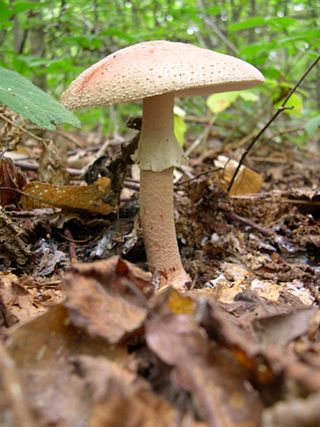
The blusher is the common name for several closely related species of the genus Amanita. A. rubescens, or the blushing amanita, is found in Europe and Asia, and A. novinupta, also known as the new bride blushing amanita or blushing bride. is found in western North America. Both their scientific and common names are derived from the propensity of their flesh to turn pink upon bruising or cutting.
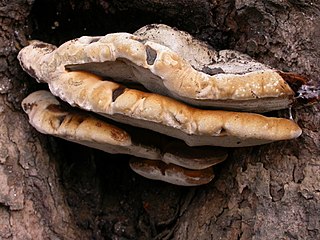
Inonotus arizonicus is a plant pathogen. I. arizonicus is a locally common saprotrophic polypore that induces white rot in sycamore trees in southwestern North America. Host species include Platanus wrightii and Platanus racemosa. The fruiting bodies, shaped like hooves or a plate or a stack of plates, can appear on trunks, at the base of living trees, or on stumps or snags. In California this species is generally found south of the San Francisco Bay Area.
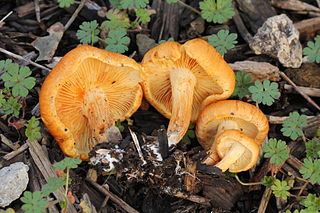
Gymnopilus aurantiophyllus is a species of mushroom-forming saprotrophic fungus in the family Hymenogastraceae.
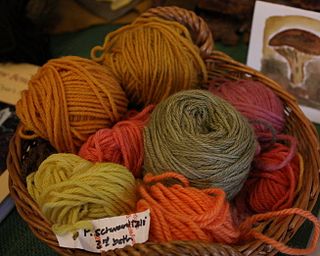
Mushrooms can be used to create color dyes via color-extraction with a solvent as well as particulation of raw material. The shingled hedgehog mushroom and related species contain blue-green pigments, which are used for dyeing wool in Norway. The fruiting body of Hydnellum peckii can be used to produce a beige color when no mordant is used, and shades of blue or green depending on the mordant added. Phaeolus schweinitzii produces green, yellow, gold, or brown colors, depending on the material dyed and the mordant used.

Amanita magniverrucata, commonly known as the pine cone amanita, or great pine jewel, is a species of agaric mushroom in the family Amanitaceae. First described scientifically by American mycologists Harry Delbert Thiers and Joseph Ammirati in 1982, it is mycorrhizal and associates with the tree Pinus radiata, which is commonly known as the Monterey pine.

Cortinarius smithii, also known as the western red dye mushroom, is an agaric fungus of the genus Cortinarius. Originally named Cortinarius phoeniceus var. occidentalis by American mycologist Alexander H. Smith in 1939, it was renamed to honor Smith in 2012, after molecular analysis revealed that it was genetically different from Cortinarius phoeniceus. It is found in North America.

Amanita augusta, commonly known as the western yellow-veil or western yellow-veiled amanita, is a small tannish-brown mushroom with cap colors bright yellow to dark brown and various combinations of the two colors. The mushroom is often recognizable by the fragmented yellow remnants of the universal veil. This mushroom grows year-round in the Pacific Northwest but fruiting tends to occur in late fall to mid-winter. The fungus grows in an ectomycorrhizal relationship with hardwoods and conifers often in mixed woodlands.

Cantharellus roseocanus, commonly known as the rainbow chanterelle, is a species of fungus in the family Cantharellaceae. Found in the Pacific Northwest region of North America, it was originally described in 1997 as a variety of Cantharellus cibarius, and later promoted to distinct species status in 2012.

Hygrophorus chrysodon, commonly known as the flaky waxy cap, or gold flecked woodwax is a species of fungus in the genus Hygrophorus. It is edible but bland in taste. The species is found throughout the Northern Hemisphere.

Aureoboletus flaviporus, commonly known as the viscid bolete, is a species of bolete fungus found in western North America, where it grows in ectomycorrhizal association with coast live oak, madrone, manzanita, and possibly with tanoak. In California, this mushroom appears during the rainy season in locations south of Mendocino County. This mushroom is "fairly common" but does not appear in large groupings, only as one-offs or small clusters in scattered locations.

Hygrocybe laetissima, also known as the cherry-red waxy cap, is a species of gilled mushroom found in North America. It appears to flourish in association with redwood forests. The authors of Mushrooms of the Redwood Coast note that this waxy cap is superficially similar to other waxy caps, including Hygrocybe splendidissima, Hygrocybe punicea, Hygrocybe aurantiosplendens, and Hygrocybe marchii. It also overlaps somewhat in range and appearance with Hygrocybe coccinea. This one has the coloration of a Rainier cherry. Not recommended as an edible mushroom because close cousins have made people sick. This mushroom species was first described by Alexander H. Smith and L. R. Hesler.
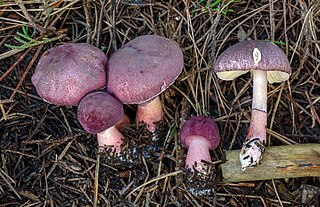
Lepiota decorata, also known as the pink parasol, is an uncommon species of gilled mushroom found in North America. The cap of L. decorata usually has a speckled violet pattern, stains orange when scratched, and is about 4 to 8 cm in diameter.

Russula cremoricolor, also known as the winter russula, is a species of gilled mushroom. This mushroom has red, cream-yellow, and pink color variants, which complicates attempts at field identification, although finding "red and creamy capped fruitbodies in close proximity is a good clue indicating this species". The winter russula is "mildly toxic," and causes intestinal distress even when consumed in small amounts. The red morph was previously identified as Russula silvicola, but was found to be genetically identical to the cream-colored individuals called R. cremoricolor. The red morph is superficially similar to Russula californiensis but R. cremicolor has a much sharper, peppier taste, likes to associate with mixed forest or tanoak rather than pine, and keeps its gills and stipe white even in age.
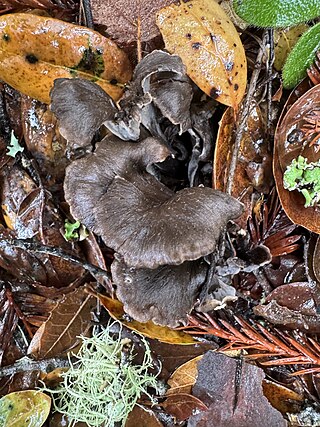
Craterellus atrocinereus, commonly known as the black chanterelle or Californiablack chanterelle, is a species of edible fungus native to western North America. This uncommon species is a mycorrhizal associate of live oak, tanoak, and Oregon white oak in Oregon and northern California, where it is found most often in the vicinity of Monterey Bay. This species has a "fruity-cheesy" odor, and fruits in winter and spring. This bluish-gray to black chanterelle was previously considered to be Craterellus cinereus but was recognized as a distinct species in 2015. The specific name is a nod to C. cinereus, with the Latin prefix atro meaning dark and cinereus referring to its smoky gray coloration.

Entoloma ferruginans is an endemic mushroom of California in North America. It smells distinctly like a chlorinated pool at the YMCA, thus the common name bleachy entoloma. E. ferruginans lives in mycorrhizal association with live oaks south of the San Francisco Bay. This mushroom was first described by Charles Horton Peck in 1895 from a type specimen collected under oak trees in Pasadena.

Caloboletus marshii, commonly known as Ben's bitter bolete, is a species of mushroom in the family Boletaceae. It is not poisonous, but it is too bitter to eat. It turns blue when cut or bruised, and it grows under live oak.

Caloboletus conifericola, commonly known as the dark bitter bolete, is a species of mushroom in the family Boletaceae. It is found in the Pacific Northwest.

Xerocomellus diffractus, commonly known as the cracked-cap bolete, is a species of mushroom in the family Boletaceae. It is found in western North America.

Hortiboletus coccyginus, commonly known as the sumac-colored bolete, is a species of mushroom in the genus Hortiboletus. It is rare.




















